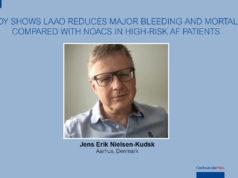
A comprehensive evaluation of mitral valve-in-valve (ViV) and valve-in-ring (ViR) procedures has found that residual mitral stenosis and/or mitral regurgitation were “relatively common”, and that both were associated with a need for repeat valve replacement. Significant residual mitral regurgitation occurred more often in ViR patients, with lower survival at four years.
Researchers Matheus Simonato (Federal University of Sao Paulo, Sao Paulo, Brazil), Danny Dvir (Shaare Zedek Medical Centre, Israel and University of Washington Medical Center, Seattle, USA) et al from the Valve-in-Valve International Data (VIVID) Registry said that strategies to improve post-procedural haemodynamics in mitral ViV and ViR should be further explored. The results were presented by Simonato at the PCR e-Course 2020 (25–27 June).
He explained: “There are limited data on the clinical significance of valve haemodynamics after transcatheter mitral valve-in-valve and valve-in-ring procedures. Our objective was to describe predictors for residual mitral stenosis and residual mitral regurgitation after these procedures, and to determine whether there is a possible influence on meaningful long-term clinical outcomes.”
The study consisted of a retrospective multicentre data collection looking at patients undergoing mitral ViV and ViR between March 2006 and March 2020. Clinical endpoints were defined according to the Mitral Valve Academic Research Consortium (MVARC). Significant residual mitral stenosis was defined as mean gradient ≥10mmHg and significant residual mitral regurgitation as ≥ moderate.
In all, 1,079 patients (857 ViV, 222 ViR; mean age 73.5 years±12.5, 40.8% male) from 90 centres were included. Median Society of Thoracic Surgery Predicted Risk of Mortality (STS-PROM) score was 8.6%, and median clinical follow-up was 492 days (Interquartile range [IQR] 76–996 days]; median echocardiographic follow-up for patients that survived one year was 772.5 days (IQR 510–1211.75 days). The four-year Kaplan-Meier survival rate was 62.5% in ViV versus 49.5% for ViR (p<0.001). Mean gradient across the mitral valve post-procedure was 5.7±2.8 mmHg (≥5mmHg, 61.4% of patients). Significant residual mitral stenosis occurred in 8.2% of the ViV and 12% of the ViR patients (p=0.09). Significant residual mitral regurgitation was more common in ViR patients (16.6% vs. 3.1%, p<0.001), and was associated with lower survival at four years (35.1% vs. 61.6%; p=0.02). The rates of MVARC-defined device success were low for both procedures (39.4% total: 32% ViR vs. 41.3% ViV, p=0.01), and were mostly related to having a post-procedural mean gradient ≥5mmHg. Correlates for residual mitral stenosis were smaller true internal diameter, younger age and larger body mass index. The only correlate for residual MR was ViR.
Significant residual mitral stenosis (subhazard ratio [SHR] 4.67, 95% confidence interval [CI] 1.74–12.56, p=0.002) and significant residual mitral regurgitation (SHR 7.88, 95% CI 2.88–21.53, p<0.001) were both independently associated with repeat mitral valve replacement.
Summing up, Simonato said: “Mitral ViR patients had higher mortality and required more redo mitral valve replacement at four-year follow-up. Residual mitral regurgitation was associated with higher mortality … residual mitral stenosis was not predictive of patient mortality, but was associated with repeat mitral valve replacement.”
And, he advised: “Operators of ViV and ViR procedures should aim for achieving optimal haemodynamics in these procedures.”
Analysing the findings for Cardiovascular News, Simonato said: “This is the first time that the clinical relevance of residual mitral stenosis and mitral regurgitation are extensively evaluated in the mitral valve-in-valve/valve-in-ring population. Our findings are relevant as we show that gradients between 5mmHg and 9mmHg are not associated with suboptimal clinical outcomes, even though they are considered device failure in current MVARC definitions. Gradients ≥10mmHg are not associated with mortality, but may lead to increased rates of mitral valve replacement. Strategies to improve post-procedural haemodynamics probably involve better device positioning, improved sizing algorithms, and balloon dilatation. However, there is little data supporting these techniques, and further studies on the topic are still needed.
Dvir told Cardiovascular News: “Suboptimal haemodynamics of mitral valve-in-valve and mitral valve-in-ring should lead to procedural strategies to improve post-implantation haemodynamics in order to optimise device durability.” He also mentioned that, since the suboptimal survival of patients having mitral valve-in-ring procedures extends to four years with approximately 50% mortality, alternative therapies to mitral valve-in-ring in patients with mitral valve failure after surgical repair should be considered.











